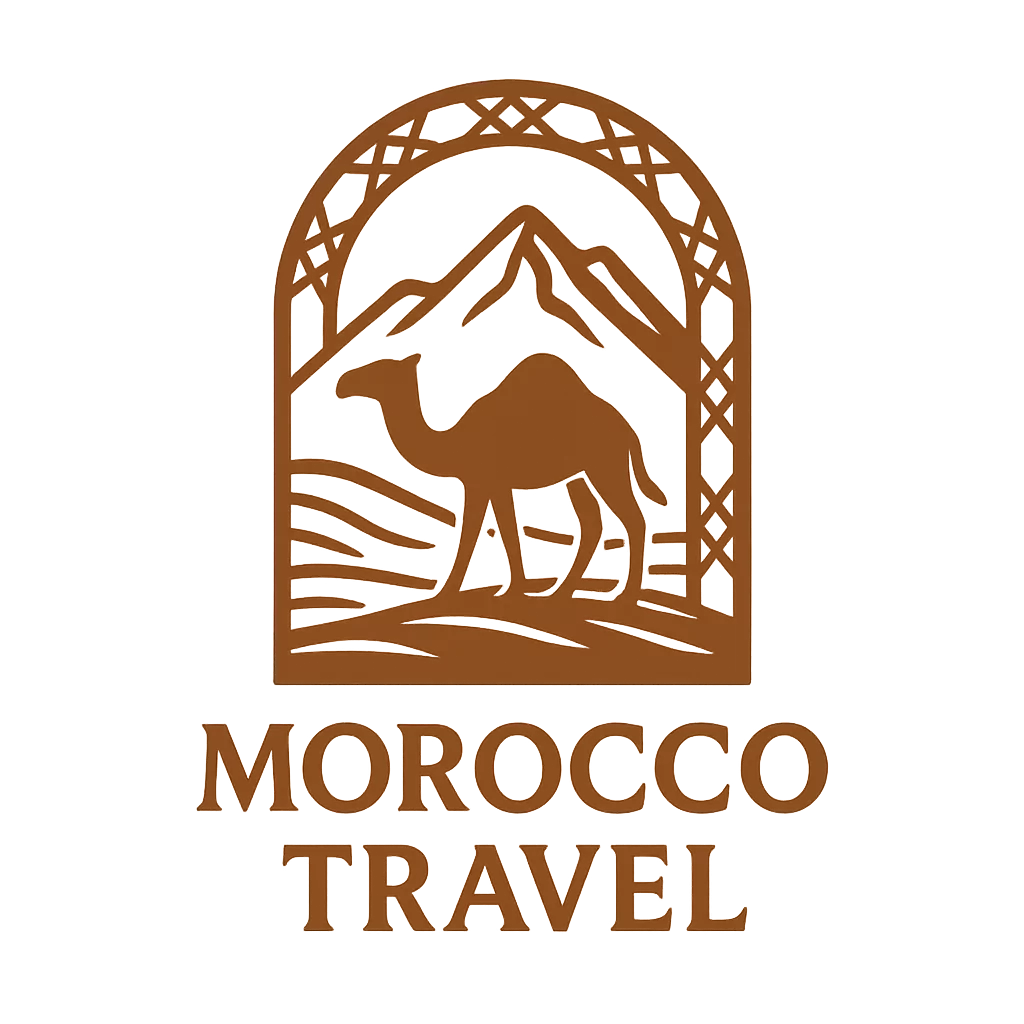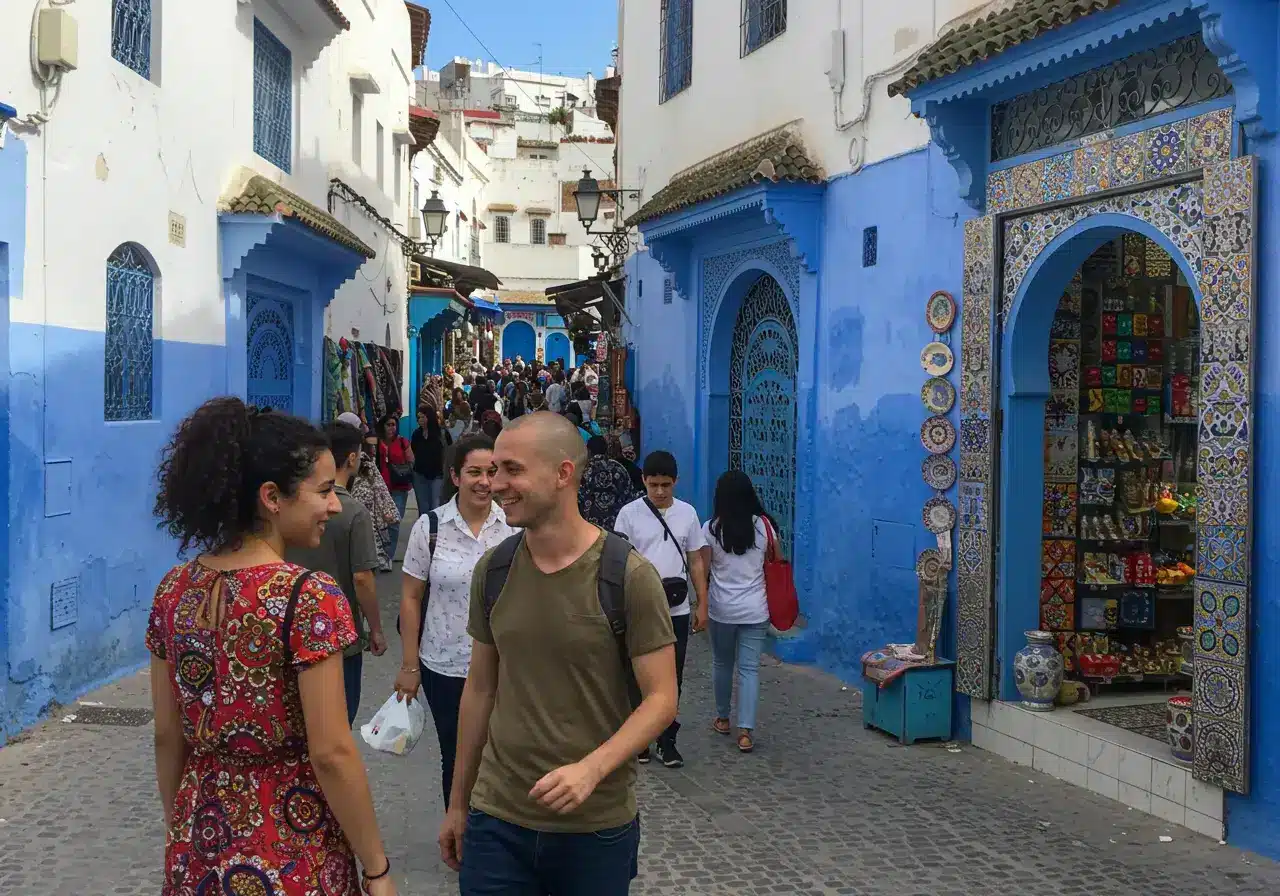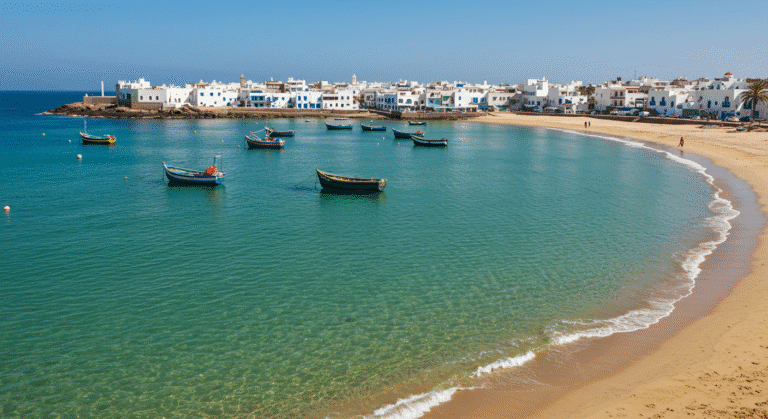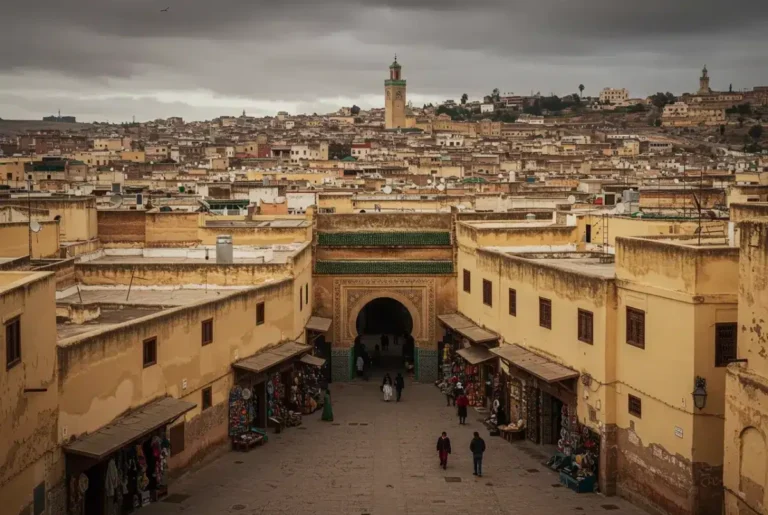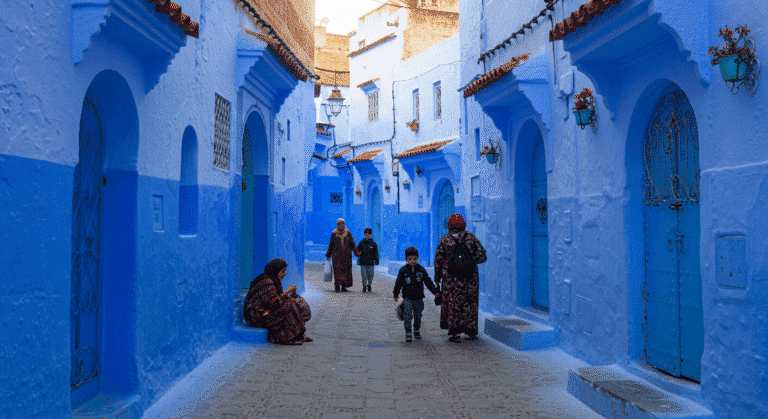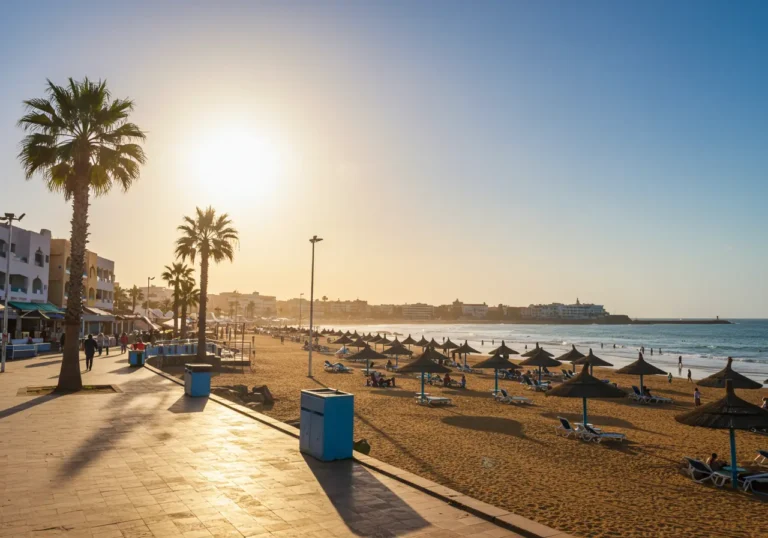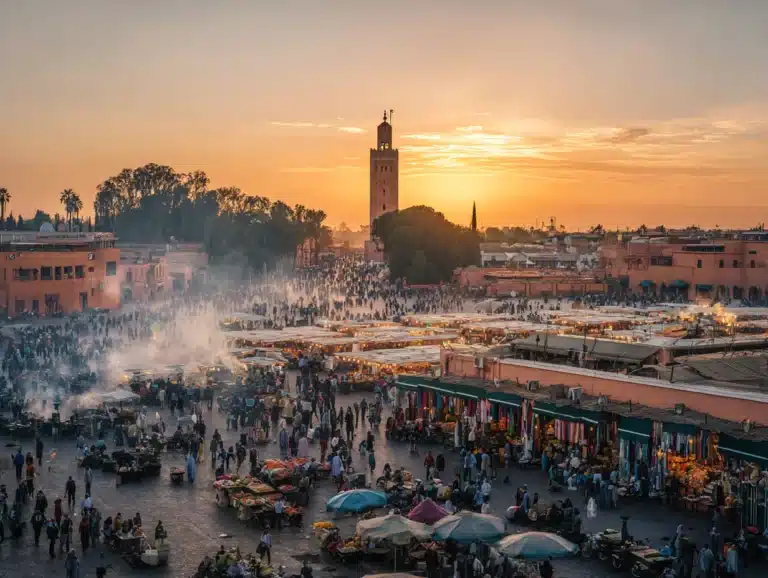Tangier Guide: Gateway to Northern Morocco
Is Tangier Worth The Journey North?
Have you ever wondered why Tangier has captivated the imagination of artists, writers, and adventurers for centuries, yet remains overlooked by mainstream tourism? Positioned at Africa’s northernmost edge, Tangier stands just 14 kilometers from Spain, making it not only Morocco’s gateway to Europe but also one of the most strategically significant coastal cities in North Africa. Despite welcoming over 1 million visitors annually, Tangier receives 40% fewer tourists than Marrakech, creating a perfect balance of infrastructure without overwhelming crowds.
My three visits to Tangier over the past decade have revealed a city transforming rapidly while maintaining its enigmatic charm. As Morocco’s fastest-developing northern hub (with 12.8% tourism growth in 2023), Tangier offers an authentic blend of Moroccan, Spanish, French, and indigenous Amazigh influences that you simply can’t experience elsewhere in the country.
Travel Checklist: What to Pack for Tangier
Preparing for Tangier requires thoughtful packing that respects local customs while ensuring your comfort across diverse environments from breezy coastal promenades to narrow medina alleyways.
Essential Items:
- Modest, breathable clothing: Lightweight cotton pants, maxi skirts, and shirts that cover shoulders (especially for women visiting religious sites)
- Comfortable walking shoes: Tangier’s hilly terrain and cobblestone streets demand supportive footwear
- Light jacket or layer: Evening sea breezes can drop temperatures by 8-10°C, particularly from October through April
- Sun protection: Wide-brimmed hat, sunglasses, and SPF 50+ sunscreen (the North African sun reflects intensely off whitewashed buildings)
- Secure day bag: Crossbody style with hidden compartments for navigating busy markets
- Universal power adapter: Morocco uses Type C/E outlets (230V)
- Basic first aid kit: Including stomach remedies, as water adjustment affects nearly 30% of first-time visitors
Digital Essentials:
- Offline maps: Download Google Maps for Tangier before arrival
- Translation app: French and Arabic phrases (installed offline)
- Currency converter: The Moroccan dirham (MAD) isn’t widely available outside Morocco
Pro Tip:
Pack a lightweight scarf regardless of gender. Beyond modesty for mosque visits, it provides sun protection during scorching summer days when temperatures regularly exceed 30°C and shields against the occasional sand-laden winds that sweep through Tangier from the Sahara.
Best Time to Visit Tangier
Tangier’s Mediterranean climate creates distinct travel experiences throughout the year, each offering unique advantages for different travel styles.
Spring (April-May): The Goldilocks Season
Spring represents Tangier’s perfect balance with average temperatures between 18-24°C, blooming hillsides, and tourist numbers 35% below summer peaks. Hotel rates remain 15-20% cheaper than July-August, while offering the city’s sunniest period (averaging 9 hours of sunshine daily). The annual Tangier Jazz Festival typically falls in late May, adding cultural richness to your visit.
Summer (June-August): Peak Season
While summer brings perfect beach weather (with sea temperatures averaging a pleasant 23°C), it also delivers Tangier’s highest tourist density and accommodation prices. July visitors face rates approximately 40% higher than shoulder seasons, alongside daytime temperatures that frequently reach 28-32°C. However, Tangier’s position at Africa’s northern tip means it enjoys noticeably milder summers than Morocco’s interior cities, where temperatures regularly exceed 40°C.
Autumn (September-October): The Insider’s Choice
September and October offer what many locals consider Tangier’s most appealing climate warm days (20-26°C) with comfortable evenings, while the Mediterranean remains swimmable at 21-22°C. Tourist numbers drop by approximately 25% from August levels, creating a sweet spot of good weather, reduced crowds, and declining hotel rates.
Winter (November-March): Budget-Friendly Season
Winter brings Tangier’s rainiest period (with December averaging 12 rainy days), but rewards flexible travelers with hotel rates up to 60% below summer prices. Daytime temperatures remain mild (14-17°C), though evenings can feel quite cool. The famous Mediterranean light that has inspired countless artists appears at its most dramatic during winter months, creating spectacular sunset conditions over the Strait of Gibraltar.
Data-Driven Recommendation:
For the optimal balance of comfortable weather, reasonable prices, and cultural experiences, plan your Tangier visit during the last two weeks of September when you’ll find 40% fewer tourists than August, temperatures averaging a pleasant 24°C, and accommodation rates beginning their post-summer decline.
Step-by-Step Tangier Itinerary
Day 1: Historic Medina Immersion
Morning: Cultural Orientation
Begin at the Grand Socco (officially Place du 9 Avril 1947) the historic circular plaza marking the entrance to Tangier’s ancient medina. From here, follow the sloping pathway past the distinctive minaret of the Sidi Bou Abib Mosque toward Petit Socco, once Tangier’s notorious heart during its international zone period. Stop at Café Tingis, where mint tea costs just 12 MAD (approximately $1.20), for people-watching beneath centuries-old architecture.

Afternoon: Literary Legacy
Tangier’s international mystique owes much to its literary connections. Visit the American Legation Museum (40 MAD entrance), established in 1821 as America’s first public property abroad. Beyond diplomatic history, its dedicated Paul Bowles room celebrates the American author who immortalized Tangier in “The Sheltering Sky.” Follow this with a visit to Librairie des Colonnes, the bookshop frequented by literary giants including Tennessee Williams, Truman Capote, and Allen Ginsberg during Tangier’s international zone years.
Evening: Sunset Perspective
As afternoon light softens, make your way to the Kasbah Tangier’s highest point timing your arrival for sunset. The panoramic view spans two continents across the Strait of Gibraltar, with Spain’s coast visible just 14 kilometers away on clear days. Dine at Café Restaurant Kasbah, where traditional Moroccan dishes are served on a terrace with unmatched views. Try their tagine jardin (vegetable tagine) for 85 MAD.
Day 2: Coastal Exploration
Morning: Cape Spartel & Hercules Cave
Begin your second day exploring Tangier’s mythical coastal landmarks. Hire a petit taxi (approximately 100 MAD round trip with waiting time) to Cape Spartel, where the Atlantic Ocean meets the Mediterranean Sea. The 19th-century lighthouse marks Africa’s northwestern extremity.
Just 2.5 kilometers south lies the Caves of Hercules (entrance 20 MAD), a natural and partially man-made cave complex steeped in mythology. The cave’s ocean opening resembles Africa’s shape a perfect photo opportunity that generates over 25,000 Instagram posts annually.
Afternoon: Beach Culture
Return to Tangier for lunch at Miami Beach Club on the city’s expansive beach. Here, for approximately 150 MAD per person, you can enjoy fresh seafood while overlooking the azure waters that have drawn visitors since the Phoenicians established the settlement over 2,500 years ago.
Spend your afternoon experiencing Tangier’s beach culture along the Bay of Tangier. Unlike southern Morocco’s beaches, Tangier’s shoreline features remarkable cleanliness following the city’s 135 million euro waterfront development project completed in 2018.
Evening: New City Dining
For dinner, explore Tangier’s nouvelle ville, centered around Boulevard Mohammed V. El Tangerino offers contemporary Moroccan cuisine with French influences, reflecting the city’s multicultural heritage. Their pastilla au poumon (pigeon pie with cinnamon and almonds) represents one of Morocco’s most sophisticated culinary traditions for 130 MAD.
Day 3: Day Trip Adventures
Choose one of these enriching day trips from Tangier:
Option A: Chefchaouen Blue City
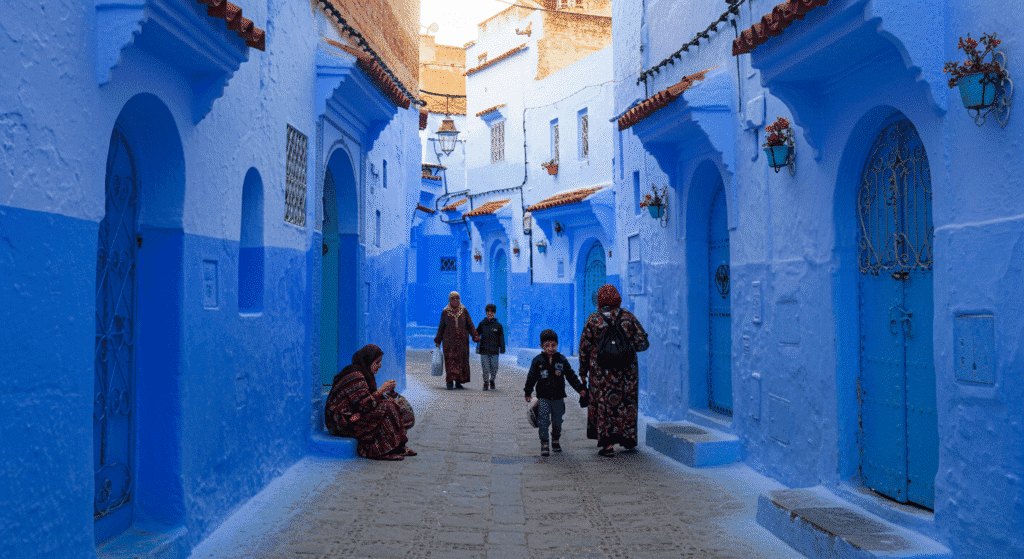
Morocco’s famed “Blue Pearl” lies 115 kilometers southeast of Tangier (approximately 2.5 hours by bus). CTM buses depart daily at 8:15 AM (75 MAD each way). Chefchaouen’s distinctive blue-washed buildings create one of North Africa’s most photogenic environments. Return buses depart at 14:00, giving you approximately 4 hours to explore the compact medina.
Option B: Asilah Artistic Haven
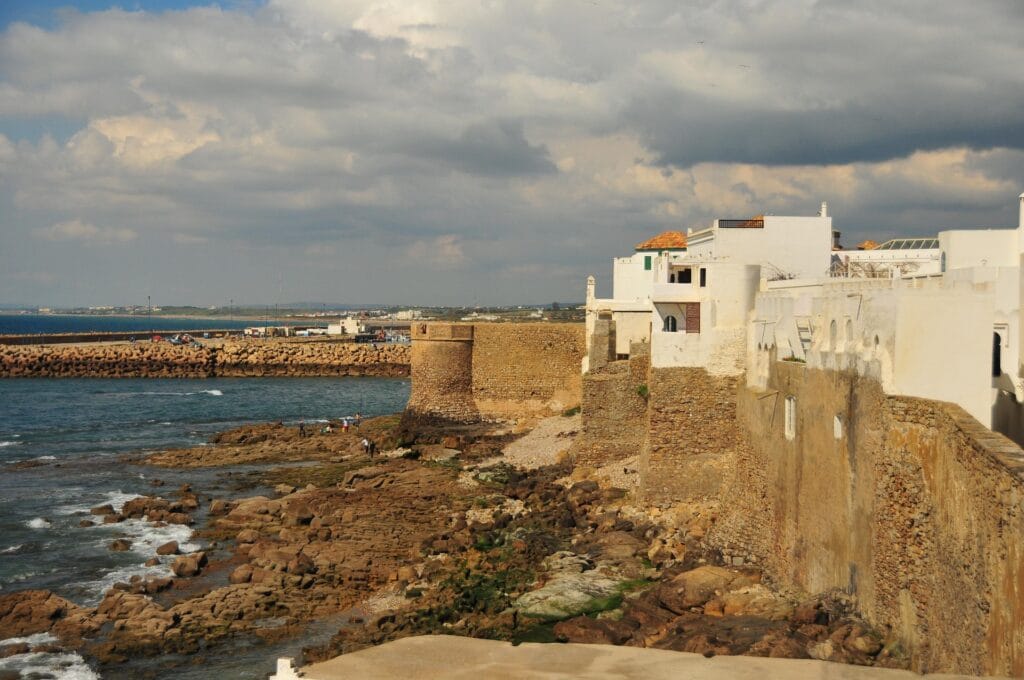
Just 40 kilometers south of Tangier (30 minutes by train, 20 MAD), Asilah offers a more relaxed coastal experience. This former Portuguese fortress town transforms each summer during the Asilah Arts Festival, when international artists create public murals throughout the medina. Even outside festival season, approximately 50 murals remain visible year-round.
Option C: Tetouan’s UNESCO Heritage
Located 60 kilometers east of Tangier (1 hour by grand taxi, approximately 25 MAD per seat), Tetouan boasts Morocco’s most Hispanic-influenced medina a UNESCO World Heritage site. The Royal Artisan School offers visitors the chance to observe traditional Moroccan crafts being taught using centuries-old techniques.
Day 4: Modern Tangier & Departure
Morning: Contemporary Culture
Begin your final day at the Tangier American Language Center (TALC) gallery, which showcases emerging Moroccan artists. Nearby, Villa Harris houses the Museum of Contemporary Art, displaying works that reflect Tangier’s position at the crossroads of cultures.
Afternoon: Final Explorations
Based on your departure time, visit the recently renovated Port of Tangier City, where a 290 million euro investment has transformed the former industrial port into a marina and cultural complex. Stop at the Tangier Artisan Center for last-minute souvenirs priced 30-40% lower than in touristy medina shops.
Book Your Trip Now
Budget Breakdown: Tangier Travel Costs
Tangier offers exceptional value compared to European destinations, with costs approximately 60% lower than Spain’s Costa del Sol just across the strait.
Accommodation (per night):
- Budget: Hostels and basic guesthouses from 150-250 MAD ($15-25)
- Mid-range: Boutique riads and 3-star hotels from 450-800 MAD ($45-80)
- Luxury: 5-star hotels and premium riads from 1200 MAD ($120+)
Daily Food Costs:
- Budget: Street food and local cafés: 100-150 MAD ($10-15) daily
- Mid-range: Mix of restaurants and cafés: 200-350 MAD ($20-35) daily
- Luxury: Fine dining and international cuisine: 500+ MAD ($50+) daily
Transportation:
- Airport to city center: 250 MAD ($25) by private taxi, 20 MAD ($2) by public bus
- Petit taxi around city: 20-30 MAD ($2-3) per trip
- Day trip transportation: 150-300 MAD ($15-30) depending on destination
Activities:
- Museum entrances: 20-50 MAD ($2-5) per site
- Guided tours: From 200 MAD ($20) for group walking tours to 1000 MAD ($100) for private day excursions
Money-Saving Tips:
- Negotiate taxi prices before entering the vehicle (15-30% discount typically possible)
- Visit hammams in late afternoon when rates drop by approximately 20%
- Purchase a local SIM card (40 MAD for 10GB) rather than using international roaming
- Exchange money at banks rather than hotels to save approximately 8% on exchange rates
Cultural Immersion: Beyond Typical Tourism
Tangier’s true essence emerges through experiences that connect visitors with local perspectives and sustainable practices.
Community-Based Tourism:
- Tangier Cooking Class: Learn traditional recipes in a family home through Atelier Cuisine de Tangier (350 MAD per person), where 15% of proceeds support local education initiatives.
- Traditional Craft Workshops: The nonprofit Fondation Tanger Al Madina offers 3-hour weaving and pottery classes (200 MAD) that preserve vanishing crafts while supporting artisan livelihoods.
Eco-Friendly Experiences:
- Cap Spartel Nature Walks: Join guided hikes (150 MAD) through the protected ecological zone surrounding Africa’s northwestern point, home to 200+ bird species.
- Organic Farm Visits: Several farms in Tangier’s surrounding hills offer half-day experiences (400 MAD) showcasing sustainable agriculture techniques adapted to North Africa’s changing climate.
Digital Nomad Integration:
With fiber optic internet now available throughout central Tangier (average speeds of 100Mbps) and co-working spaces like Dar Zero offering monthly memberships from 1000 MAD, Tangier has emerged as North Africa’s fastest-growing digital nomad hub. Unlike Marrakech, where approximately 65% of digital nomads stay less than one month, Tangier’s community sees average stays of 2.5 months.
Food & Dining Suggestions: Tangier’s Culinary Landscape
Tangier’s strategic position has created a remarkable culinary fusion that blends Moroccan traditions with Mediterranean and international influences.
Must-Try Local Specialties:
- Chermoula Fish: Fresh-caught Mediterranean fish marinated in cilantro, preserved lemon, and cumin. Try it at Restaurant Populaire Saveur de Poisson (no menu just daily fresh offerings for approximately 150 MAD per person).
- Tangier Rfissa: Unlike the chicken version found elsewhere in Morocco, Tangier’s seafood rfissa combines shredded msemen (flatbread) with a saffron-infused seafood stew. Casa Garcia serves an exemplary version (120 MAD).
- El Maquila: This Tangier-specific street food consists of fresh sardines stuffed with chermoula, battered, and fried. Find the city’s best from evening vendors near Cinema Rif (25 MAD per portion).
Atmospheric Dining Experiences:
- Café Hafa: Established in 1921, this terraced café clinging to the cliffs has served its famous mint tea to cultural icons from the Rolling Stones to Paul Bowles. The minimalist menu offers tea (10 MAD) and cookies, but the panoramic strait views are the real attraction.
- El Morocco Club: Hidden in the Kasbah, this stylish restaurant-lounge captures Tangier’s cosmopolitan past. Their seven-vegetable couscous (160 MAD) pairs beautifully with house-made orange blossom water cocktails while a jazz pianist plays evenings from Thursday through Sunday.
- Gran Café de Paris: Located on the busy Boulevard Pasteur, this historic café has remained virtually unchanged since the 1960s. Order a nous-nous (half coffee, half milk, 15 MAD) and watch the parade of humanity along Tangier’s main thoroughfare.
Culinary Insight:
Tangier’s position as a major fishing port means seafood prices average 30% lower than in Casablanca or Marrakech. For the freshest selection at non-tourist prices, visit the Port de Pêche in early morning (around 7 AM) when local restaurants make their daily purchases.
Common Mistakes to Avoid in Tangier
Navigation Pitfalls:
- Getting lost in the Medina: While Tangier’s medina is smaller than Fez or Marrakech, approximately 30% of first-time visitors become disoriented in its winding streets. Solution: Drop a pin on your offline map application at major landmarks and hotels.
- Overpaying for taxis: Unlike major European cities, Tangier taxis rarely use meters despite regulations requiring them. Negotiate fares before entering, with most in-city rides costing 20-30 MAD maximum.
- Missing the last ferry: If day-tripping to Spain, note that winter ferry schedules reduce dramatically, with the last return often departing Tarifa at 18:00 rather than 21:30 during summer months.
Cultural Misunderstandings:
- Inappropriate photography: Always ask permission before photographing locals, especially women and elderly people. Approximately 65% of travelers report negative interactions resulting from unsolicited photography.
- Visiting the medina on Fridays: Most authentic shops close from 11:30 AM to 2:00 PM for Friday prayers, leaving mainly tourist-oriented vendors operating.
- Neglecting mosque etiquette: Non-Muslims cannot enter most Moroccan mosques, with the Hassan II Mosque in Casablanca being a notable exception. Photographing mosques from outside is generally acceptable.
Booking Blunders:
- Overlooking location: Hotels advertising “sea views” may actually be located in busy port areas with industrial rather than scenic vistas. Research exact locations using satellite map views.
- Ignoring seasonal considerations: December through February brings an average of 10 rainy days per month, making rooftop terraces and outdoor experiences less enjoyable.
- Missing riad reservation requirements: Many traditional guesthouses require cash payment and don’t have 24-hour reception. Confirm check-in procedures before arrival.
Safety & Travel Tips for Tangier
General Safety:
Tangier ranks among Morocco’s safest major cities with serious crime rates approximately 30% lower than Casablanca. However, petty theft and scams targeting tourists occur, particularly in crowded areas like the medina and train station.
Practical Precautions:
- Carry minimal valuables: Use hotel safes for passports and excess cash
- Avoid deserted medina streets after 10 PM: Stick to well-lit, populated areas
- Decline unsolicited guiding services: Unauthorized “guides” often lead to commission-heavy shops
- Use ATMs attached to major banks: Preferably during daylight hours to reduce skimming risk
Essential Applications:
- Maps.me: Functions without data connection for medina navigation
- XE Currency: Updated conversion rates even when offline
- Translator with Arabic/French packages: Downloaded for offline use
Communication Tips:
- Purchase a local SIM card at the airport or from Maroc Telecom stores (passport required)
- Basic French phrases prove more useful than English outside tourist areas
- Learn basic Arabic greetings (“Salam alaikum” for hello, “Shukran” for thank you) to enhance interactions
Health Considerations:
- Tap water meets WHO standards but tastes heavily chlorinated; most visitors prefer bottled water
- Pharmacies (identified by green crosses) offer consultations and prescription-free medications for minor ailments
- Hospital Ibn Battouta provides the city’s best emergency care, with English-speaking staff available
Conclusion: Tangier’s Transformative Experience
Straddling two continents while embodying multiple cultures, Tangier rewards travelers with experiences impossible elsewhere. From watching the sunset paint the Strait of Gibraltar in gold from a cliff-side café to navigating ancient medina passageways where international spies once exchanged secrets, Tangier delivers historical depth alongside modern developments.
Despite ongoing modernization including Africa’s first high-speed rail line connecting to Casablanca Tangier maintains its enigmatic character that has captivated visitors for centuries. As Paul Bowles wrote, “Tangier is a place where the past and present exist simultaneously,” a quality that remains true today, making it the perfect introduction to Morocco’s multifaceted appeal.
Have you experienced Tangier’s unique charm? Share your stories, questions, or tips in the comments below. For personalized recommendations or to receive our monthly newsletter featuring hidden Moroccan destinations, subscribe using the form below.
FAQ’s About Tangier
Is Tangier safe for solo female travelers?
Tangier ranks among Morocco’s safer cities for solo female travelers, though unwanted attention occurs. Dress modestly (shoulders and knees covered), project confidence, and consider scheduling medina exploration during morning hours when harassment reports are approximately 40% lower than evenings.
How many days should I spend in Tangier?
While 43% of visitors see Tangier as a one-day stopover between Spain and other Moroccan destinations, a minimum of three days allows proper exploration of both historical sites and surrounding attractions. Those incorporating day trips to Chefchaouen or Asilah should allocate 4-5 days.
Do I need a visa to visit Tangier?
Visitors from 76 countries, including the US, UK, EU, Canada, and Australia, receive visa-free entry for 90 days. Always verify current requirements through official Moroccan diplomatic websites as regulations change periodically.
What currency should I bring to Tangier?
The Moroccan dirham (MAD) cannot legally be imported or exported. Exchange currency upon arrival or withdraw from ATMs offering favorable rates. Major establishments accept credit cards (with typical 2-3% foreign transaction fees), though cash dominates smaller businesses.
Is Tangier worth visiting compared to other Moroccan cities?
Tangier offers a distinctive experience that complements rather than competes with Morocco’s other destinations. While Marrakech provides sensory intensity and Fez preserves medieval authenticity, Tangier’s international character and progressive outlook create Morocco’s most cosmopolitan environment.
What languages are spoken in Tangier?
Darija (Moroccan Arabic) predominates, but Tangier’s international history makes it Morocco’s most multilingual city. Approximately 35% of residents speak Spanish, 45% speak French, and English proficiency continues growing, especially among those under 30.
How conservative is Tangier regarding dress code?
While more progressive than rural Morocco, respectful attire remains important. Beachwear should remain on beaches, and visiting religious sites requires covered shoulders, knees, and heads (for women). The city center sees approximately 65% of local women wearing headscarves, compared to nearly 90% in smaller Moroccan towns.
